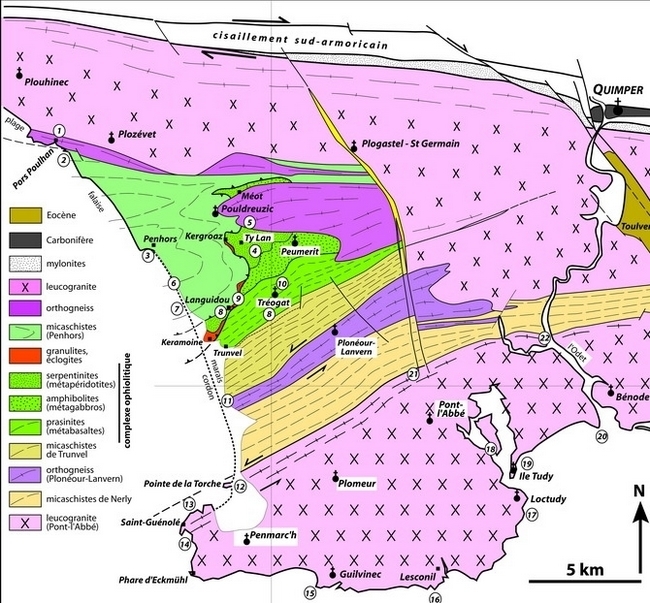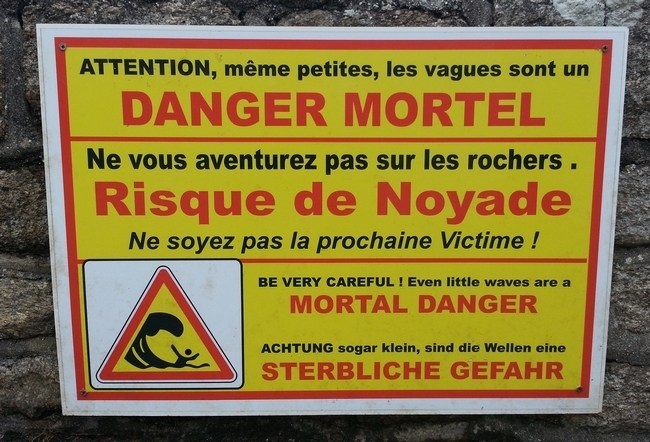
Une paréidolie est un phénomène qui consiste à identifier une forme familière dans un paysage, dans un nuage ou comme ici sur la côte de Saint-Guénolé, dans des rochers …
A Saint-Guénolé, les rochers les plus pittoresques de la côte ont étés baptisés mais l’absence de noms bretons et le choix de certains termes laissent à penser que la plupart de ces noms sont nés de l’imagination des premiers touristes. Des noms qui furent aussitôt assimilés par les gamins et gamines du Menez qui se transformaient volontiers en guides en échange de quelques pièces. De même les premiers éditeurs de cartes postales, toujours à la recherche de pittoresque, contribuèrent à les populariser et à fixer leurs noms.
 |
 |
Parmi les rochers les plus connus on trouvera les oreilles de lapin, la tête de cheval ou tête de veau, le Moine, la Tortue, le Crapaud, la Chaise longue ou encore le Tire-bouchon ou Rhinocéros que vous trouverez aux coordonnées de cette earthcache.
A parureidolia is a phenomenon that consists of identifying a familiar form in a landscape, in a cloud or like here on the coast of Saint-Guénolé, in rocks ...
At Saint-Guénolé, the most picturesque rocks of the coast have been baptized, the lack of Breton names and the choice of certain terms suggest that most of these names are born from the imagination of the first tourists. Names that were immediately assimilated by the boys and girls of Menez who willingly turned into guides in exchange for a few pieces. In the same way the first publishers of postcards, always in search of picturesque, contributed to popularize them and fix their names.
Among the most famous rocks we find the rabbit ears, the horse's head or calf's head, the monk, the turtle, the toad, the chaise longue or the corkscrew or rhinoceros that you will find at the coordinates of this earthcache .
D'un point de vue géologique / From a geological point of view

Les rochers de Saint-Guénolé sont constitués de leucogranite dit de Pont-l'Abbé. Ce leucogranite est un granite de teinte claire à deux micas (biotite et muscovite). Il est le plus souvent à gros grain, mais peut aussi présenter un aspect plus feuilleté ou être fissuré par des diaclases, donnant alors, à cause de l'érosion, des chaos granitique dont la forme a fécondé l'imaginaire populaire.
The rocks of Saint-Guénolé are made of Leucogranite known as Pont-l'Abbé. This leucogranite is a light-colored granite with two micas (biotite and muscovite). It is usually coarse, but may also have a more flaky appearance or be cracked by diaclases, giving, due to erosion, granitic chaos whose shape has fertilized the popular imagination.
Différents types d'érosion / Different types of erosion
Si le granite est une roche dure et résistante, il manque de souplesse. C’est ainsi que, lors des mouvements de l’écorce terrestre et au cours de son refroidissement, le granite, sous l’action des contraintes, va se fissurer. Les fractures apparues, qui portent le nom de diaclases, faciliteront l’altération en permettant à l’eau de pénétrer plus facilement à l’intérieur de la roche. Sans ces diaclases, le granite, roche imperméable ne s’altérerait que difficilement. Et si la surface de la roche était nue, l’eau, ruissellerait à la surface mais ne stagnerait pas, d’où une altération très réduite. L’altération se fait donc principalement le long des zones où l’eau circule, dans les fissures et les diaclases.
Les variations de température agissent aussi sur la cohésion du granite. Elles entraînent des dilatations et des contractions successives. Soumise à ces variations de volume incessantes, le granite se fissure puis éclate. C'est la thermoclastie. La fissuration est plus importante dans les roches composées de minéraux différents n'ayant pas le même coefficient de dilatation. Des microfissures apparaissent alors à la limite entre les minéraux. Un phénomène surtout observé dans les régions de forte amplitude thermique.
Enfin dans les zones soumises au gel interviendra aussi le phénomène de cryofracturation. L’eau qui s’infiltre dans les diaclases augmentera de volume lors des périodes de gel, participant ainsi à l’élargissement des diaclases et au démantèlement de l’affleurement.
L'érosion éolienne est aussi une forme d'érosion qui attaque les roches en enlevant des particules par déflation et abrasion en polissant la surface. Elle est d'autant plus efficace que les obstacles sont inexistants et que le vent est puissant, régulier et chargé de poussières.
Un dernier type d'érosion s'observe dans les zones à fortes fréquentation humaine, la corrosion pédologique entraînant, avec l’apparition d’une encoche, la genèse de pittoresques « rochers-champignons ».
If granite is a hard and resistant rock, it lacks flexibility. Thus, during the movements of the earth's crust and during its cooling, the granite, under the action of the stresses, will crack. The fractures that have arisen, which are called joints, will facilitate weathering by allowing water to more easily penetrate the interior of the rock. Without these joints, granite, an impermeable rock, would hardly deteriorate. And if the surface of the rock were bare, water would run off the surface but not stagnate, resulting in very little weathering. The weathering therefore occurs mainly along areas where water circulates, in cracks and joints.
Temperature variations also act on the cohesion of the granite. They lead to successive dilations and contractions. Subjected to these incessant variations in volume, the granite cracks and then bursts. It is thermoclasty. Cracking is greater in rocks composed of different minerals that do not have the same coefficient of expansion. Microcracks then appear at the boundary between the minerals. A phenomenon observed especially in regions of high thermal amplitude. Finally, in areas subject to frost, the phenomenon of freeze-fracturing will also occur. The water that seeps into the joints will increase in volume during periods of frost, thus helping to widen the joints and dismantle the outcrop.
Wind erosion is also a form of erosion that attacks rocks by removing particles by deflation and abrasion by polishing the surface. It is all the more effective when there are no obstacles and the wind is powerful, regular and loaded with dust.
A final type of erosion is observed in areas with heavy human use, soil corrosion causing, with the appearance of a notch, the genesis of picturesque "mushroom rocks".
Chacun des minéraux du granite réagit différemment à l’altération
En plus de l'altération mécanique, il existe une érosion chimique qui affecte les roches. Ainsi :
- Le mica noir (ou biotite), à cause de la présence de fer dans sa composition, va se transformer assez rapidement en hydroxyde de fer et en argile. Hydrolyse de la biotite : 2 K(Fe,Mg)3AlSi3O10(OH)2 (Biotite)+ 17 H2O →Si2O5Al2(OH)4 (Kaolinite)+ 6 FeO(OH) (Limonite/Goethite) + 4 Si(OH)4 +2 K+ + 2 OH-
- Le mica blanc (ou muscovite), ne s’altère guère. Il va d'abord se fragmenter en petites paillettes de même composition chimique : la séricite. Une hydrolyse est cependant possible qui conduira par perte de potassium à de l'illite puis à de la kaolinite ou à des smectites selon les conditions.
- Le quartz, est inaltérable. Une fois séparé des autres éléments, il fournit l'essentiel du sable
- Les feldspaths, par hydrolyse, vont se transformer en argiles. Selon les conditions, ces hydrolyses pourront se faire selon des réactions différentes et donc conduire à des composés différents. De plus tous les feldspaths ne sont pas sensibles de la même façon à l'hydrolyse. Les phénocristaux, présents dans certains granites, résisteront mieux à l'altération.
Each of the minerals in granite reacts differently to weathering
In addition to mechanical weathering, there is chemical erosion that affects rocks. So :
- Black mica (or biotite), because of the presence of iron in its composition, will transform fairly quickly into iron hydroxide and clay. Hydrolysis of biotite: 2 K(Fe,Mg)3AlSi3O10(OH)2 (Biotite)+ 17 H2O →Si2O5Al2(OH)4 (Kaolinite)+ 6 FeO(OH) (Limonite/Goethite) + 4 Si(OH)4 +2 K+ + 2 OH-
- White mica (or muscovite) hardly changes. It will first fragment into small flakes of the same chemical composition: sericite. Hydrolysis is however possible which will lead by loss of potassium to illite then to kaolinite or to smectites depending on the conditions.
- Quartz is unalterable. Once separated from the other elements, it provides most of the sand
- Feldspars, by hydrolysis, will turn into clays. Depending on the conditions, these hydrolyses may be carried out according to different reactions and therefore lead to different compounds. In addition, not all feldspars are sensitive to hydrolysis in the same way. The phenocrysts, present in some granites, will resist weathering better.
Pour valider votre découverte / To validate your discovery
Rendez-vous aux coordonnées de cette earthcache et répondez à la première question :
1 - Aux coordonnées quels sont les 2 type d'érosion les plus visibles sur ce rocher ?
Au second waypoint (N 47° 49.178' W 4° 22.810') :
2 - Aux coordonnées quelle forme pouvez-vous observer sur le rocher le plus proche ? Quel type d'érosion est le plus visible sur ce rocher ?
Au troisième waypoint (N 47° 49.109' W 4° 22.818')
3 - Aux coordonnées quelle forme pouvez-vous observer sur le rocher le plus proche ? Quel type d'érosion est le plus visible sur ce rocher ?
4 - Enfin en quoi vont se transformer les leucogranites dit de Pont-l'Abbé (la réponse se trouve dans le texte de présentation de cette earthcache)
Go to the coordinates of this earthcache and answer the first question:
1 - At the coordinates what are the 2 types of erosion (of the 3 cited on this page) most visible on this rock?
At the second waypoint (N 47 ° 49.178 'W 4 ° 22.810'):
2 - At the coordinates which shape can you observe on the nearest rock? What type of erosion is most visible on this rock?
At the third waypoint (N 47 ° 49.109 'W 4 ° 22.818')
3 - At the coordinates which shape can you observe on the nearest rock? What type of erosion is most visible on this rock?
4 - Finally what will transform the leucogranites known as Pont-l'Abbé ? (the answer can be found in the presentation text of this earthcache)

La cotation terrain 1 de cette earthcache n'est valable que si vous restez sur le chemin bordant la côte rocheuse. Soyez prudent en cas de météo pluvieuse et ne vous aventurez pas sur les rochers glissants. Pour observer la météo en direct vous pouvez visualiser la vue via cette webcam située sur le port de Saint-Guénolé.
The terrain rating 1 is valid only if you stay on the path bordering the rocky coast. Be careful in case of rainy weather and do not venture on slippery rocks. To observe the weather live you can view the view via this webcam located on the port of Saint-Guénolé.
Loguez cette cache "Found it" et envoyez-moi vos 4 réponses soit via mon profil, soit via la messagerie geocaching.com (Message Center), et je vous contacterai en cas de problème. N'hésitez pas à poster une photo du rocher qui vous aura le plus inspiré !
Log in this "Found it" cache and send me your four answers either via my profile or via the geocaching.com (Message Center) mail, and I will contact you in case of a problem. Do not hesitate to post a photo of the rock that will have inspired you the most!
Pour rappel : il n'y a pas de boîte à trouver pour valider une earthcache ! Vous pouvez loguer votre découverte mais devez aussi m'envoyer vos réponses au plus vite. Une photo de vous avec votre rocher préféré agrémentera votre log mais n'est pas obligatoire !
To remind: there is no box to find to validate an earthcache! You can log your discovery but also send me your answers as soon as possible. A photo of you with your favorite rock will enhance your log but is not mandatory!
Sources : http://saint-guenole.net/rochers-de-saint-guenole/ et http://utlpaysbigouden.fr/wp/2238/la-geologie-bigoudene-et-ses-curiosites-sylvain-blais-professeur-de-geologie-en-retraite
http://pmb.bretagne-vivante.org:8090/pmb/uploads/PAB_schulke_1971_67.pdf
https://www.geowiki.fr/index.php?title=Alt%C3%A9ration_du_granite